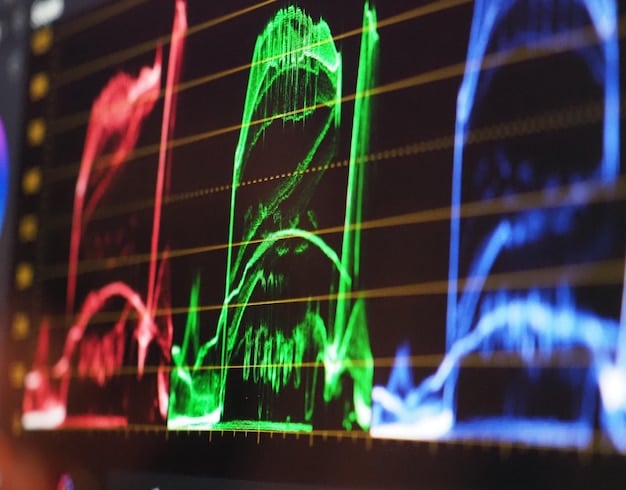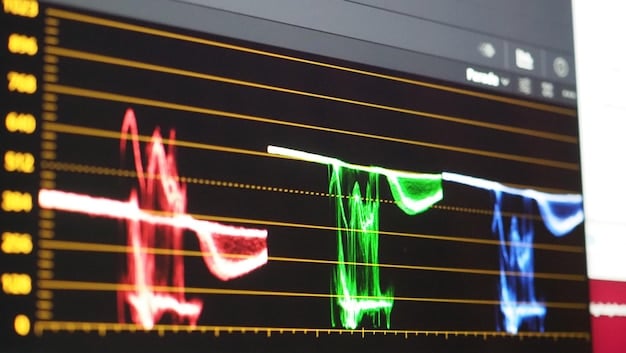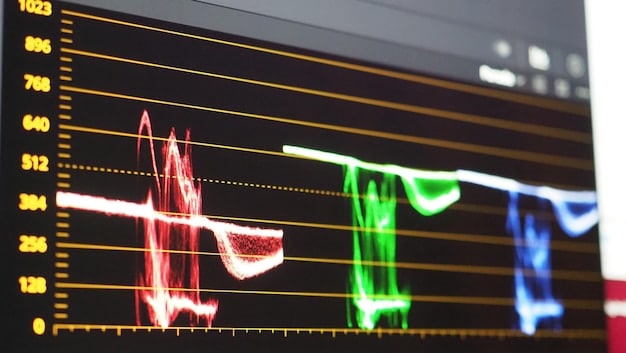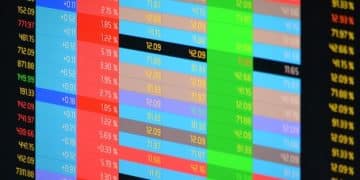Master High-Probability Trading Setups with Technical Indicators

Technical indicators are essential tools for traders looking to identify high-probability trading setups by providing insights into price trends, momentum, and potential entry and exit points.
Are you looking to enhance your trading strategy and increase your chances of success? Mastering the art of using technical indicators to identify high-probability trading setups can be a game-changer. Let’s explore how these powerful tools can help you make more informed decisions and improve your trading outcomes.
Understanding Technical Indicators for Trading
Technical indicators are calculations based on the price and volume of a security, used to forecast future price movements. They provide traders with a way to analyze historical data and identify patterns that can suggest potential trading opportunities, helping to identify high-probability trading setups.
What are Technical Indicators?
Technical indicators are mathematical calculations based on historical data of a stock’s price and volume. These indicators are used to forecast potential price movements and identify patterns.
By analyzing these patterns, traders can make informed decisions about when to enter and exit trades, improving their chances of profitability. They are fundamental when trying to identify high-probability trading setups.
Types of Technical Indicators
There are various types of technical indicators, each designed to provide different insights into market behavior. Understanding these types can help traders select the most appropriate indicators for their trading strategy.
- Trend Indicators: Help to identify the direction of the price trend. Examples include Moving Averages and MACD.
- Momentum Indicators: Measure the speed and strength of price movements. Examples include RSI and Stochastic Oscillator.
- Volume Indicators: Analyze the volume of trading to confirm the strength of a trend or identify potential reversals. Examples include On Balance Volume (OBV) and Accumulation/Distribution Line.

Technical indicators are essential tools for traders seeking to understand market dynamics and identify high-probability trading setups. These indicators help in making informed trading decisions by analyzing historical data.
Using Moving Averages for Trend Identification
Moving averages (MAs) are one of the most popular and widely used technical indicators. They smooth out price data by creating a single flowing line that represents the average price over a specified period. This helps traders identify the overall trend and potential support and resistance levels, hence being useful to identify high-probability trading setups.
Simple Moving Average (SMA)
The Simple Moving Average is calculated by adding up the closing prices for a specific period and dividing by the number of periods. It gives equal weight to each data point.
For example, a 50-day SMA averages the closing prices of the last 50 days. The SMA is useful for identifying long-term trends and potential areas of support and resistance. It can be a solid tool to identify high-probability trading setups.
Exponential Moving Average (EMA)
The Exponential Moving Average gives more weight to recent prices, making it more responsive to new information compared to the SMA. This can be particularly useful in volatile markets.
The EMA is better for identifying short-term trends and potential entry and exit points. This makes it a reliable method to identify high-probability trading setups.
- Identify Overall Trends: Use MAs to determine the prevailing trend of a stock.
- Find Support and Resistance: Look for areas where the price tends to bounce off the MA line.
- Generate Trading Signals: Use crossovers of different MAs to identify potential buy or sell signals.
Moving Averages are fundamental in trend identification, helping traders to identify high-probability trading setups by smoothing out price data. The choice between SMA and EMA depends on the trader’s preference and trading style.
Identifying Overbought and Oversold Conditions with RSI
The Relative Strength Index (RSI) is a momentum indicator that measures the magnitude of recent price changes to evaluate overbought or oversold conditions in the price of a stock or other asset. It oscillates between 0 and 100, with readings above 70 typically indicating overbought conditions and readings below 30 indicating oversold conditions. Traders use RSI to identify high-probability trading setups.
How RSI Works
The RSI calculates the ratio of average gains to average losses over a specified period, usually 14 days. The formula helps traders gauge the strength of a stock’s price momentum.
When the RSI is above 70, it suggests the stock may be overbought and due for a correction. Conversely, an RSI below 30 suggests the stock may be oversold and poised for a bounce, making it easier to identify high-probability trading setups.

Using RSI to Generate Trading Signals
Traders use RSI to generate buy and sell signals. An RSI reading below 30 indicates a potential buying opportunity, while a reading above 70 suggests a selling opportunity. Combining RSI with other indicators can improve the accuracy of these signals and help identify high-probability trading setups.
- Overbought Conditions: RSI above 70 indicates the asset is overbought.
- Oversold Conditions: RSI below 30 indicates the asset is oversold.
- Divergence: Look for divergence between price and RSI to confirm signals.
The RSI is a valuable tool for traders to identify high-probability trading setups by identifying potential overbought and oversold conditions. Combining RSI with other technical analysis techniques can provide more robust trading signals.
MACD for Momentum and Trend Confirmation
The Moving Average Convergence Divergence (MACD) is a trend-following momentum indicator that shows the relationship between two moving averages of a security’s price. The MACD is calculated by subtracting the 26-period Exponential Moving Average (EMA) from the 12-period EMA. A nine-day EMA of the MACD, called the “signal line,” is then plotted on top of the MACD, functioning as a trigger for buy and sell signals and helping to identify high-probability trading setups.
Understanding MACD Components
The MACD consists of three main components: the MACD line, the signal line, and the histogram. These components work together to provide traders with a comprehensive view of the stock’s momentum and trend.
The MACD line shows the difference between the two EMAs, while the signal line smooths out the MACD line, making it easier to identify potential crossovers. The histogram represents the difference between the MACD line and the signal line, providing additional insight into the strength of the trend and its ability to identify high-probability trading setups.
Using MACD to Generate Trading Signals
Traders use MACD to generate buy and sell signals based on crossovers, divergences, and histogram patterns. A bullish crossover occurs when the MACD line crosses above the signal line, indicating a potential buying opportunity. A bearish crossover occurs when the MACD line crosses below the signal line, suggesting a selling opportunity which aids to identify high-probability trading setups.
- Crossovers: Look for bullish and bearish crossovers to identify potential entry and exit points.
- Divergence: Identify divergence between price and MACD to confirm signals.
- Histogram Patterns: Use histogram patterns to assess the strength of the trend.
The versatility of MACD helps traders identify high-probability trading setups by offering insights into both momentum and trend. Combining MACD with other technical analysis techniques can enhance the reliability of trading signals.
Volume Indicators to Confirm Price Action
Volume indicators play a crucial role in technical analysis by providing insights into the strength and validity of price movements. Volume represents the number of shares or contracts traded during a specific period. Analyzing volume can help traders confirm trends, identify potential reversals, and identify high-probability trading setups.
On Balance Volume (OBV)
On Balance Volume is a cumulative indicator that adds volume on up days and subtracts volume on down days. It helps traders gauge the buying and selling pressure behind a stock’s price movement.
When the OBV is rising, it suggests that buying pressure is strong, and the stock price is likely to continue rising. Conversely, a falling OBV indicates strong selling pressure, and the stock price is likely to decline which helps when trying to identify high-probability trading setups.
Accumulation/Distribution Line
The Accumulation/Distribution Line considers the relationship between the closing price and the high-low range for a period. It estimates whether a stock is accumulating or distributing based on where the price closes within its range. It is also useful for traders looking to identify high-probability trading setups.
If the price closes near the high of the range with high volume, it suggests accumulation, while a close near the low of the range with high volume indicates distribution.
- Confirm Trends: Use volume to confirm the strength and validity of price trends.
- Identify Reversals: Look for divergences between price and volume to anticipate potential reversals.
- Gauge Buying and Selling Pressure: Analyze volume indicators to understand the underlying forces driving price movements and identify high-probability trading setups.
Volume indicators are important tools for traders to identify high-probability trading setups by assessing the strength of price movements. Integrating volume analysis with other technical indicators can provide more reliable trading signals.
Combining Multiple Indicators for High-Probability Setups
To increase the probability of successful trades, it’s essential to combine multiple technical indicators. Using a combination of indicators can provide a more comprehensive view of the market and help filter out false signals which allows traders to identify high-probability trading setups.
Strategies with Combined Indicators
Combining indicators can enhance signal accuracy and improve trading performance. For example, using the RSI to identify overbought/oversold conditions and then using the MACD to confirm the potential reversal can provide a strong trading signal for traders trying to identify high-probability trading setups.
Consider a strategy that uses Moving Averages to identify the trend, RSI to find potential entry points, and Volume Indicators to confirm the strength of the move. Another approach is to use trend-following indicators like Moving Averages with momentum indicators like RSI and MACD to determine optimal entry and exit points thus helping you identify high-probability trading setups.
Risk Management Techniques
Effective risk management is critical when trading with technical indicators. Always use stop-loss orders to limit potential losses and manage your position size to control risk exposure.
- Trend Confirmation: Confirm trends with volume indicators.
- Entry Points: Use RSI to find optimal entry points during overbought or oversold conditions and identify high-probability trading setups.
- Stop-Loss Orders: Always use stop-loss orders to manage risk.
Combining technical indicators can enhance trading success where the goal is to identify high-probability trading setups, but it’s essential to use effective risk management techniques to protect your capital. Mastering these strategies can lead to more informed and profitable trading decisions.
| Key Point | Brief Description |
|---|---|
| 📈 Moving Averages | Smooth price data to identify trends and support/resistance levels. |
| ⚖️ RSI | Measures overbought and oversold conditions, providing potential entry/exit points. |
| 📊 MACD | Indicates momentum and trend direction via EMA relationships. |
| 💰 Volume Indicators | Confirms price action and gauges buying/selling pressure. |
FAQ
▼
Beginners should start with simple moving averages, RSI, and MACD. These indicators are easy to understand and can provide valuable insights into market trends and momentum
▼
It’s best to use two to three complementary indicators to avoid conflicting signals. Too many indicators can lead to analysis paralysis and confusion.
▼
No, technical indicators are tools for analysis, not guarantees of profit. They provide insights but should be used with risk management and sound trading strategies.
▼
Adjust settings based on market volatility and personal trading preferences. Regularly review and tweak settings to align with current conditions.
▼
Use historical data to simulate trades and evaluate the strategy’s performance. Ensure your backtesting includes various market conditions to assess robustness.
Conclusion
Mastering the use of technical indicators can significantly enhance your trading strategy and improve your odds of success when trying to identify high-probability trading setups. By understanding and combining various indicators, such as moving averages, RSI, MACD, and volume indicators, traders can gain a more comprehensive view of the market, identify potential trading opportunities, and effectively manage risk. Continuous learning and adaptation are key to successful trading in the dynamic world of stock markets.





